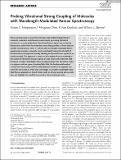Files in this item
Probing vibrational strong coupling of molecules with wavelength-modulated raman spectroscopy
Item metadata
| dc.contributor.author | Menghrajani, Kishan S. | |
| dc.contributor.author | Chen, Mingzhou | |
| dc.contributor.author | Dholakia, Kishan | |
| dc.contributor.author | Barnes, William L. | |
| dc.date.accessioned | 2021-12-01T12:30:08Z | |
| dc.date.available | 2021-12-01T12:30:08Z | |
| dc.date.issued | 2021-11-28 | |
| dc.identifier | 276891689 | |
| dc.identifier | 03504858-0ce4-4f24-b2fa-8b7d8025851b | |
| dc.identifier | 85119952196 | |
| dc.identifier | 000722930100001 | |
| dc.identifier.citation | Menghrajani , K S , Chen , M , Dholakia , K & Barnes , W L 2021 , ' Probing vibrational strong coupling of molecules with wavelength-modulated raman spectroscopy ' , Advanced Optical Materials , vol. Early View , 2102065 . https://doi.org/10.1002/adom.202102065 | en |
| dc.identifier.issn | 2195-1071 | |
| dc.identifier.other | RIS: urn:4FDABE5DAE919E9CD0337E8D7C339E9E | |
| dc.identifier.other | ORCID: /0000-0002-6190-5167/work/104252405 | |
| dc.identifier.uri | https://hdl.handle.net/10023/24452 | |
| dc.description | Funding: Engineering and Physical Sciences Research Council. Grant Number: EP/L015331/1 European Research Council. Grant Number: ERC-2016-AdG-742222 Leverhulme Trust. Grant Number: 11715R. | en |
| dc.description.abstract | Raman spectroscopy is a powerful technique that enables fingerprinting of materials, molecules, and chemical environments by probing vibrational resonances. In many applications, the desired Raman signals are masked by fluorescence, either from the molecular system being studied, or from adjacent metallic nanostructures. Here, it is shown that wavelength-modulated Raman spectroscopy provides a powerful way to significantly reduce the strength of the fluorescence background, thereby allowing the desired Raman signals to be clearly recorded. This approach is made use of to explore Raman scattering in the context of vibrational strong coupling, an area that has thus far been problematic to visualise. Specifically, strong coupling between the vibrational modes in a polymer and two types of confined light field, the fundamental mode of a metal-clad microcavity, and the surface-plasmon modes of an adjacent thin metal film are looked at. While clear advantages in using the wavelength-modulated Raman approach are found, these results on strong coupling are inconclusive, and highlight the need for more work in this exciting topic area. | |
| dc.format.extent | 11 | |
| dc.format.extent | 1848433 | |
| dc.language.iso | eng | |
| dc.relation.ispartof | Advanced Optical Materials | en |
| dc.subject | Optical microcavity | en |
| dc.subject | Plasmonics | en |
| dc.subject | Raman spectroscopy | en |
| dc.subject | Vibrational strong coupling | en |
| dc.subject | QC Physics | en |
| dc.subject | QD Chemistry | en |
| dc.subject | DAS | en |
| dc.subject.lcc | QC | en |
| dc.subject.lcc | QD | en |
| dc.title | Probing vibrational strong coupling of molecules with wavelength-modulated raman spectroscopy | en |
| dc.type | Journal article | en |
| dc.contributor.institution | University of St Andrews. School of Physics and Astronomy | en |
| dc.contributor.institution | University of St Andrews. Sir James Mackenzie Institute for Early Diagnosis | en |
| dc.contributor.institution | University of St Andrews. Centre for Biophotonics | en |
| dc.contributor.institution | University of St Andrews. Biomedical Sciences Research Complex | en |
| dc.identifier.doi | https://doi.org/10.1002/adom.202102065 | |
| dc.description.status | Peer reviewed | en |
This item appears in the following Collection(s)
Items in the St Andrews Research Repository are protected by copyright, with all rights reserved, unless otherwise indicated.

